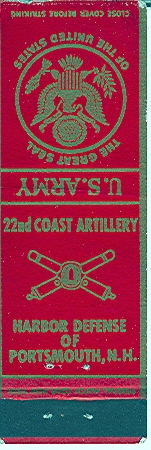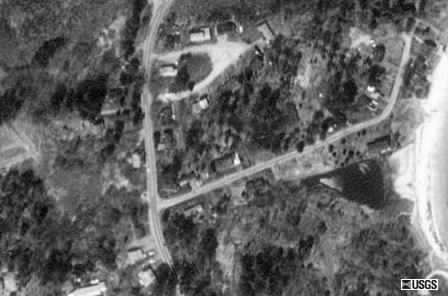History of Camp Langdon
Portsmouth Harbor Defense Headquarters, 1909-1946
Situated along the coast of New Castle Island, between Fort Constitution and Fort Stark, lies the former Camp Langdon, originally known simply as the New Reservation. The U.S. Army began acquiring the land in 1909 through several deeds, eventually totaling 32.3 acres. The original purpose of the reservation was to be an artillery post and as a center for the anti-aircraft intelligence service for Portsmouth Harbor.
World War I Era
During World War I, Anti-Aircraft Battery No. 1 was located here. It consisted of two 3-inch fixed-mount guns, Model 1917. A temporary ammunition shelter was also built, but most wartime stores were stored at either Fort Stark or Fort Constitution. A fire-control cable was connected to the reservation from both forts. Officers' quarters were also built. No other large gun batteries were emplaced here.
After the war the guns remained, and the 197th Coast Artillery Regiment (Anti-Aircraft), New Hampshire National Guard, was allowed to use the property for training purposes. A 36-inch General Electric trailer-mounted searchlight (harbor position #4) was emplaced at the center shoreline of the reservation in 1921. An 8-foot high wooden tower was built for the light. The light was shipped to Fort Heath, Boston, in 1925. In 1937 the reservation was renamed New Castle Military Reservation. The two AA guns were long removed by this time (by 1930?), and a new third emplacement was then built about 50 yards from the original two mounts, for the use of a mobile 3-inch anti-aircraft artillery gun. There is no further record however of any AA guns actually emplaced here after the original two guns were removed.

courtesy Coast Defense Study Group
Coast Defense Study Group Journal, volume 12, issue 2
Anti-Aircraft Gun, 3-inch Fixed, Model 1917

Map based on 1920 US Army Corps of Engineers site map.
Other buildings are unknown to author.

digital scan courtesy of Jon Woolf
1938 Anti-Aircraft Defense Plan.
(click for larger image - 447 KB JPEG file)
World War II
In 1941 the reservation was renamed Camp Langdon (after state Governor John Langdon) (see also N.H. war heroes), and construction of several buildings was undertaken by the Construction Quartermaster until 1943. Among these buildings were an armory, barracks, hospital, training buildings, storehouses, warehouses, and a concrete jetty and pier. A 60-inch Sperry searchlight (position #10) was located at the southern boundary on a steel tower. The post was named Headquarters, Harbor Defences of Portsmouth. The post also served as a training and recruiting center for National Guard troops. The previous harbor headquarters was located at Fort Constitution, under the 124th Coast Artillery Company, U.S. Army from 1902 to 1907, and then under the 156th Coast Artillery Company (Mines), U.S. Army from 1907 to 1924. During the inter-war years, the Portsmouth defenses were put on caretaker status, under the aegis of the Portland Coast Defenses, Maine. A detachment of five men from Battery E, 8th Coast Artillery Regiment (Harbor Defense), U.S. Army served as caretakers, and resided at the Officers' quarters at Camp Langdon.

from "Waiting for the Enemy: Memoirs of a WWII soldier serving in wartime New England and Europe"
unpublished, courtesy of Ron Hope
PFC Norman E. Hope standing on the parade ground of Camp Langdon.
The outer harbor is in the background.
See Norman Hope's photos of the 1942 USO Camp Show at Camp Langdon
The 22nd Coast Artillery Regiment (Harbor Defense), U.S. Army, formed in 1940, was originally organized as a reserve unit, the 614th Coast Artillery Battalion, New Hampshire National Guard, in 1924. In 1935 it became a unit of the regular Army. Camp Langdon became the main garrison post for the regiment in 1941. In 1943 several units of the regiment were disbanded as various gun batteries around the harbor were declared obsolete and deactivated. The surplus personnel were then reassigned to combat units then shipping out overseas to Europe and the Pacific theaters. The units remaining were then redesignated as units of the Harbor Defenses of Portsmouth. In 1946 these last units were officially disbanded.

The distinctive unit insignia of the 8th Coast Artillery Regiment. |

The distinctive unit insignia of the 22nd Coast Artillery Regiment. |
Read about the history of the Coast Artillery Regiments of the U.S. Army.

1943 matchcover - 22nd Coast Artillery |

1943 matchcover - Camp Langdon PX |
Cold War Period
In 1948 the U.S. Army transfered 27 acres of Camp Langdon to the U.S. Navy. The disposition of the remaining acreage is unknown. The Navy then referred to the post as Camp Langdon Annex, or Camp Langdon Military Reservation, which was placed under the U.S. Naval Disciplinary Command, Naval Base, Portsmouth. It was used as a rehabilitation center for courts-martial prisoners. During the 1950's several new buildings were constructed, and most of the older buildings were demolished or rebuilt. Building T-116, which still stands today south of the town library, was a small-arms indoor firing range built during this period.

Map based on 1959 US Army Corps of Engineers site map,
with former (1941) and current (1959) structures shown.
No key was given for identification of former structures.
See also 1951 U.S. Army Corps of Engineers site plan (246KB JPEG file)
In 1961 the southwestern portion of 2.8 acres, with five buildings, including T-116, was transferred to the U.S. Marine Corps for administration and training of the 54th Rifle Company, USMC Reserve. The indoor range was also used by a local gun club during this time. In 1963 the remainder of the Naval Annex was transferred to the Town of New Castle for park and recreation usage, now known as Great Island Common. In 1964 all military activity ceased at the post.
Post Military Period
In 1967 the USMC Reserve Training Center was transferred to the Town of New Castle. The New Castle Public Library is now on site, by the main entrance to the former post. The town beach is located at the northern portion of the park, near where the AA battery was located. The two concrete gun blocks still remain, near a concrete pavement and platform below the beach area. The original concrete jetty and pier also still exist. Building T-102 still stands, in the southern portion of the former post, as the park's caretaker residence. The Town of New Castle motor pool and garage is located in the former fire station (T-190), which was built by the Navy in the 1950's. Several foundations of other former structures are still evident throughout the park. Admission of $3 per person is charged to enter the park. There is no interpretation of any of the former military structures.
List of Sources Used
Official website of the Town of New Castle's Great Island Common Fees and Park Rules

north side

west side

east side
courtesy of Microsoft Terraserver
A 1992 USGS Satellite Image of Great Island Common
Proceed to Photo Gallery














